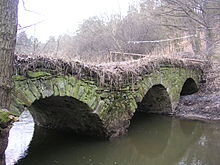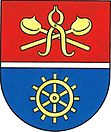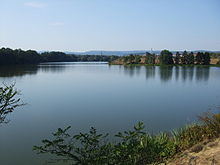Stará Huť
| Stará Huť | ||||
|---|---|---|---|---|
|
||||
| Basic data | ||||
| State : |
|
|||
| Region : | Středočeský kraj | |||
| District : | Příbram | |||
| Area : | 825.8556 ha | |||
| Geographic location : | 49 ° 47 ' N , 14 ° 12' E | |||
| Height: | 352 m nm | |||
| Residents : | 1,450 (Jan. 1, 2019) | |||
| Postal code : | 262 02 | |||
| License plate : | S. | |||
| traffic | ||||
| Street: |
Prague - Příbram Dobříš - Nový Knín |
|||
| Railway connection: | Dobříš – Praha-Modřany | |||
| structure | ||||
| Status: | local community | |||
| Districts: | 1 | |||
| administration | ||||
| Mayor : | Petr Dragoun (as of 2015) | |||
| Address: | Karla Čapka 430 262 02 Stará Huť |
|||
| Municipality number: | 541338 | |||
| Website : | www.starahut.eu | |||


Stará Huť (German Althütten ) is a municipality in the Czech Republic . It is located two kilometers east of Dobříš and belongs to the Okres Příbram .
geography
Stará Huť is located at the southern foot of the Brdská vrchovina ( Brdy Mountains ) at the transition to the Dobříšská pahorkatina ( Dobrian Hills ). The village is traversed by the Sychrovský creek, which is dammed west of Stará Huť in Huťský rybník ( Althüttner pond ) and southeast in Strž ( hammer pond ). To the north rises the Králova stolice ( Königstuhl , 412 m nm), in the south the Věžní vrch (387 m nm) and to the northwest the Kazatelna (530 m nm), the Obora (462 m nm) and the Aglaia (491 m nm). The R 4 expressway runs on the western edge of the village, and in the north the state road II / 114 between Dobříš and Nový Knín passes Stará Huť; in addition, the village is on the Dobříš – Praha-Modřany railway line .
Neighboring towns are Kodetka, Ježovka and Voznice in the north, Mokrá Vrata and Mokrovraty in the Northeast, Pod Blechhamerskou Cestou, Pouste, Porostliny, Strážovna and Kozi Hory in the east, Chramiště, U Peti Lip, Hranice and Novy Dvur in the southeast, Josefovo Údolí, Rybníky and Budínek in the south, Svaté Pole , Lhotka, Malá Strana, Rosovice and Sychrov in the south-west and Dobříš in the west and north-west.
history
In 1674 the owner of the Dobřisch estate , Franz Maximilian von Mansfeld, had an ironworks and several iron hammers built east of Dobřisch. It can be assumed that he also had a settlement built for the smelters and hammer people. This settlement was originally called Huť , Hutě Železné or Hutě Železné Dobříšské . Decisive for the foundation was the abundance of wood in the area as well as the existing hydropower of the Sychrovský potok, which was dammed for this purpose in the Althüttner pond and hammer pond. The iron stone was mined outside the rulership in Brdy near Chlumetz , Kleschtěnitz ( Kleštěnice ), Wohrazenitz , Hatie ( Hatě ), Sliwitz ( Slivice ) and Zduchowitz , only at Rochot there was an iron mine on the domain. The first hammer was located below the hammer pond dam instead of the settlement Josefovo Údolí , and the second and third hammer followed downstream in the valley of Sychrovský potok. The fourth hammer was located east of Althütten in the Kotzaba valley , below it was the tin hammer on a pond. After the construction of another ironworks near Obecnice in 1714, the settlement and the hut were given the name Stará Huť or old steelworks .
After the male line had died out in 1780 with the death of Joseph Wenzel von Mansfeld , his sister Maria Isabella inherited the Dobřisch rule. The name and coat of arms were merged with the family of her husband Franz de Paula Gundaker von Colloredo-Waldsee-Mels to the Colloredo-Mannsfeld family . After Maria Isabella's death in 1794, her son Rudolph Joseph II inherited the property. At the beginning of the 19th century he had the first iron rolling mill built in Althütten in Bohemia and at the same time in the Imperial and Royal Monarchy. Since the rolling mill operation was not profitable, Rudolph Joseph II had the rolling mill shut down and the plant converted into a machine factory. After the death of the childless Rudolf Joseph II von Colloredo-Mannsfeld, the rule fell to his nephew Franz de Paula Gundaccar II von Colloredo-Mannsfeld in 1844 .
In 1846 the village of Althütten or Stará Huť in the Berauner district consisted of 109 houses with 954 inhabitants, including two Protestant and two Jewish families. In the village there was an official shift office, an official blast furnace, an inn and two mills, one of which had a board saw. Apart from that, there was the Fünflinden ruling farm ( U Pěti Lip ), two ruling iron hammers, an ruling machine factory and an ruling forester's house ( hájovna Rybníky ). The parish was Dobřisch. The steelworks Althütten and Obetznitz together had about 600–700 employees, including charring . In addition, the rule in Althütten operated a machine factory, in which steam engines as well as hydraulic and other tools were manufactured. Until the middle of the 19th century, Althütten remained subject to the Dobřisch rule.
After the abolition of patrimonial Stará Huť / Althütten formed from 1850 a municipality in the judicial district Dobříš. In 1864 the drive of the machine factory was converted to a steam engine. The smelter, iron foundry and machine factory operated under the name of Dobříš ironworks. Mainly technical equipment for mines and sawmills, pumps and steam engines were manufactured. Cast iron manufacture became the company's main source of income. Around 1870 the iron foundry began producing toilet bowls, dishes, wash basins and bathtubs as well as agricultural equipment. Mechanical engineering components were also manufactured for the national market and for export.
From 1868 the municipality belonged to the Příbram District . In 1897 the Dobříš – Praha-Modřany railway was opened, and in 1910 Stará Huť received a stop. In 1905, Joseph Fürst Colloredo-Mannsfeld brought five muskrats with him from a trip to Canada and released the three female and two male specimens at the hut pond, the animals are considered to be the tribe of the entire Central European muskrat population. In 1913 a post office was opened in the community. In the same year the place was electrified and street lighting was installed. During the First World War , the Dobříš ironworks manufactured war equipment for the Austro-Hungarian army under military supervision. The economic crisis of the 1920s hit the Dobříš ironworks hard. During this time there was a change of ownership and finally the affiliation to other companies. The changes in production that were carried out in the process led to unprofitability and ultimately to the closure of the plant in 1926. The closure of the ironworks hit Stará Huť all the more because at that time the production of gloves, which was mainly carried out by women, was in a crisis. In 1932 Stará Huť had 1,323 inhabitants. After the end of the Second World War , heavily armed German soldiers coming from Nový Knín passed through Stará Hu z on May 9, 1945 and fled via Milín to the south-west to be taken prisoner by the Americans. On May 12, 1945 the Red Army under Marshal Malinovsky occupied the village, and in October 1945 the Soviet troops left the village. From 1949 Stará Huť belonged to the newly formed Okres Dobříš, after its abolition the community was again part of the Okres Příbram in 1960 . In 1997 and 1998 the CzechTek took place at Stará Huť . The community has had a coat of arms and a banner since 2011.
Community structure
No districts are shown for the community of Stará Huť. Stará Huť includes the Malá Strana settlement and the Rybníky, U Pěti Lip, Josefovo Údolí and Pod Blechhamerskou Cestou strata.
Attractions
- Chapel in the village square
- Remains of the fourth hammer with a ruined arch bridge over the Kocába
- Wooden arbor on Králova stolice at the star cross of six ways
- Huťský rybník and Strž ponds
- Čapek villa in Josefovo Údolí, after Karel Čapek and Olga Scheinpflugová married on August 26, 1935, Václav Palivec gave them the villa on Strž as a wedding present for lifelong use. It has served as a Karel Čapek memorial since 1963. Since the redesign in 1997, the exhibition has also been devoted to the life and work of Olga Scheinpflugová. In 1998 the exhibition on the writer and journalist Ferdinand Peroutka opened in the attic .
- Karel Čapek educational trail, opened in 2012
- Dobříš Castle and Vargač Castle, west of Stará Huť on Huťský rybník
- Evangelical cemetery on the parish border with Rybníky. Here is u. a. the tomb for Louis Reuss .
Personalities
- Josef Loukota (1879–1967), the painter lived in Stará Huť
- Václav Palivec (1882–1964), manager of the timber and brewing companies of Counts Colloredo-Mannsfeld and director of the Dobříš ironworks
- Karel Čapek (1890–1938), the poet lived with Stará Huť from 1935, in 1938 he contracted pneumonia while repairing flood damage on the Strž, from which he died.
- Martin Myšička (* 1970), the actor grew up in Stará Huť
- Jana Pechanová (* 1981), the long-distance swimmer lives in Stará Huť
Web links
Individual evidence
- ↑ http://www.uir.cz/obec/541338/Stara-Hut
- ↑ Český statistický úřad - The population of the Czech municipalities as of January 1, 2019 (PDF; 7.4 MiB)
- ↑ Johann Gottfried Sommer The Kingdom of Bohemia, Vol. 16 Berauner Kreis, 1849, pp. 230-231
- ↑ http://www.starahut.eu/index.php/o-obci/symboly-obce
- ↑ Archived copy ( memento of the original from July 24, 2015 in the Internet Archive ) Info: The archive link was inserted automatically and has not yet been checked. Please check the original and archive link according to the instructions and then remove this notice.
- ↑ http://www.capek-karel-pamatnik.cz/vismo/galerie2.asp?id_org=200013&id_galerie=1025&p1=1091
- ↑ Dieter Bald: Died 130 years ago: Memories of Louis Reuss In: Wittgenstein. Leaves of the Wittgensteiner Heimatverein eV , year 106, December 2018, vol. 82, no. 3, pp. 136-146.



